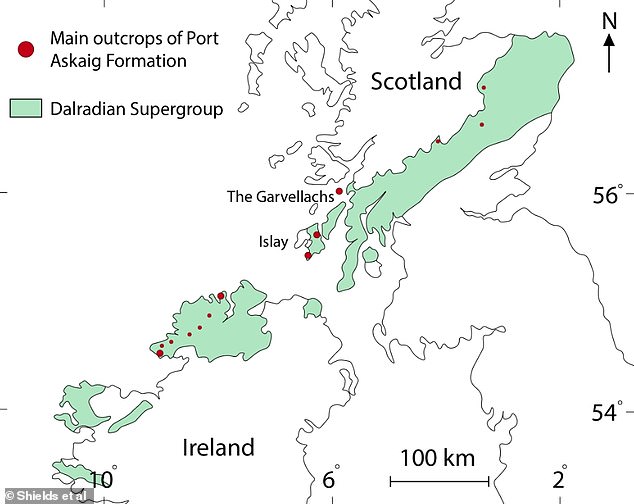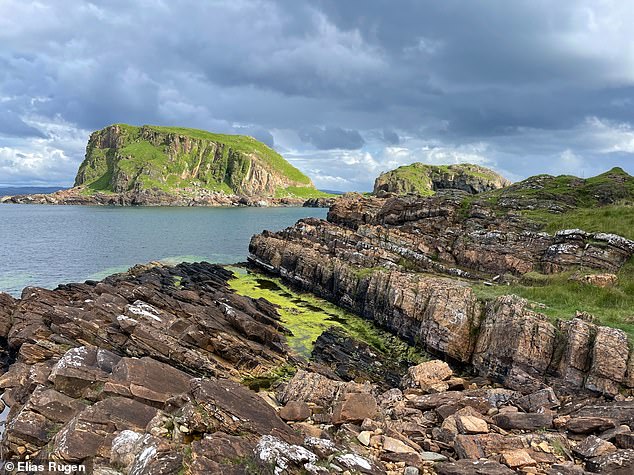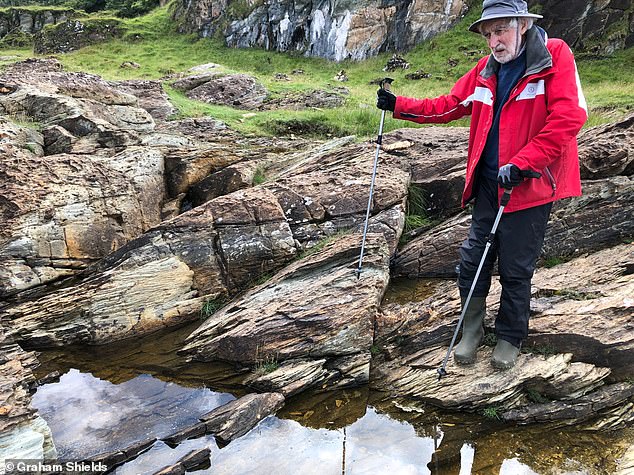A look back at ‘snowball Earth’: Rock formations in Ireland and Scotland may provide the most complete evidence of a global frost period 700 million years ago
The Earth was not always covered in lush greenery and beautiful blue oceans teeming with life.
About 700 million years ago, it was even a glittering “snowball,” an icy planet not seen in a Star Wars movie.
Scientists now say that geological remains of ‘Snowball Earth’ can still be found in Scotland and northern Ireland.
Rocks along a vast 200-mile-long formation spanning the North Channel, they say, date back to the Snowball Earth era.
After being an icy planet for about 60 million years, Earth eventually thawed, creating the right conditions for life as we know it.
About 700 million years ago, our planet plunged into a dramatic deep freeze that lasted millions of years, creating what has become known as ‘Snowball Earth’ (artist’s impression)

About 700 million years ago, Earth was a glittering ‘snowball’, an ice planet worthy of Star Wars. Pictured is the planet ‘Hoth’ from ‘Star Wars – The Empire Strikes Back’ (1980)
“These rocks are evidence of a period when the Earth was covered in ice,” said Graham Shields, professor of geology at University College London.
“All complex, multicellular life forms, such as animals, emerged from this deep freeze. The first evidence in the fossil record appeared shortly after the planet thawed.”
The ‘great freeze’ on Earth some 700 million years ago, which made the Earth resemble a giant ‘snowball’, is an event known as the Sturtian glaciation.
Scientists believe this icy transformation was likely caused by historically low levels of carbon dioxide emissions from volcanoes, effectively reversing the current greenhouse effect.
The Port Askaig Formation, which consists of layers of rock up to 1.1 km thick, was probably ‘deposited’ during the Sturtian glaciation, the authors of this study say.
‘The Port Askaig Formation is a sedimentary rock formation and so was deposited in horizontal layers,’ co-author Elias Rugen, a PhD candidate at UCL, told MailOnline.
‘Sedimentary rocks, such as those deposited under glaciers, are deposited horizontally.’

This map locates the major outcrops of the Port Askaig Formation as red dots. The Port Askaig Formation is located within a much larger body of rock called the Dalradian Supergroup (shaded in green) which contains rocks both older and younger than the Port Askaig Formation

One exposed rock outcrop of the Port Askaig Formation can be found in the Scottish Isles and is called the Garvellachs (pictured)
For the study, the researchers collected sandstone samples from the Port Askaig Formation and analyzed tiny, extremely durable minerals in the rock, called zircons.
These can be accurately dated because they contain the radioactive element uranium, which decays into lead at a steady rate.
The zircons, together with other geochemical evidence, suggest the Port Askaig rocks were deposited between 662 and 720 million years ago – which coincides with the estimated dating of the Sturtian glaciation.
‘This is the first direct dating we have for these rocks, which means the deposition of the Port Askaig Formation occurred during a snowball effect period in Earth’s history,’ Professor Shields told MailOnline.
Port Askaig not only provides the earliest rocky evidence of ‘Snowball Earth’ in Britain, but it is also perhaps the most complete evidence of global frost in the world.

Anthony Spencer, co-author of the latest study, stands on glacial mortar (sediment deposited by a glacier) from the Port Askaig Formation on Garbh Eileach, the largest of Scotland’s Garvellach Islands
Of course, Snowball Earth eventually melted as carbon emissions gradually increased and volcanic activity increased again.
‘Once the snowball melted it would mean a catastrophic change in conditions for all life forms that had adapted to the extreme cold,’ Professor Shields told MailOnline.
‘Among the winners of that arms race would have been the early ancestors of all the animals alive on Earth today.
‘Around this time, other forms of complex, multicellular life also emerged (for example, modern types of algae).
“This crossroads represents the transition from microbial-dominated ecosystems to a more complex, modern-looking living world.”
The research was published in the Journal of the Geological Society of London.
